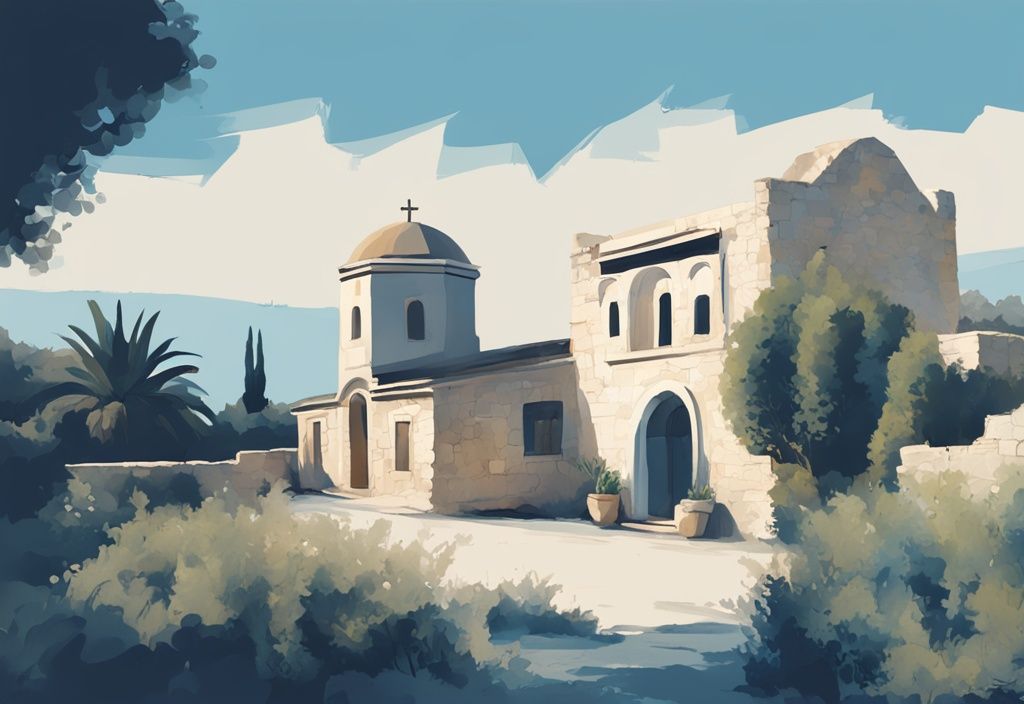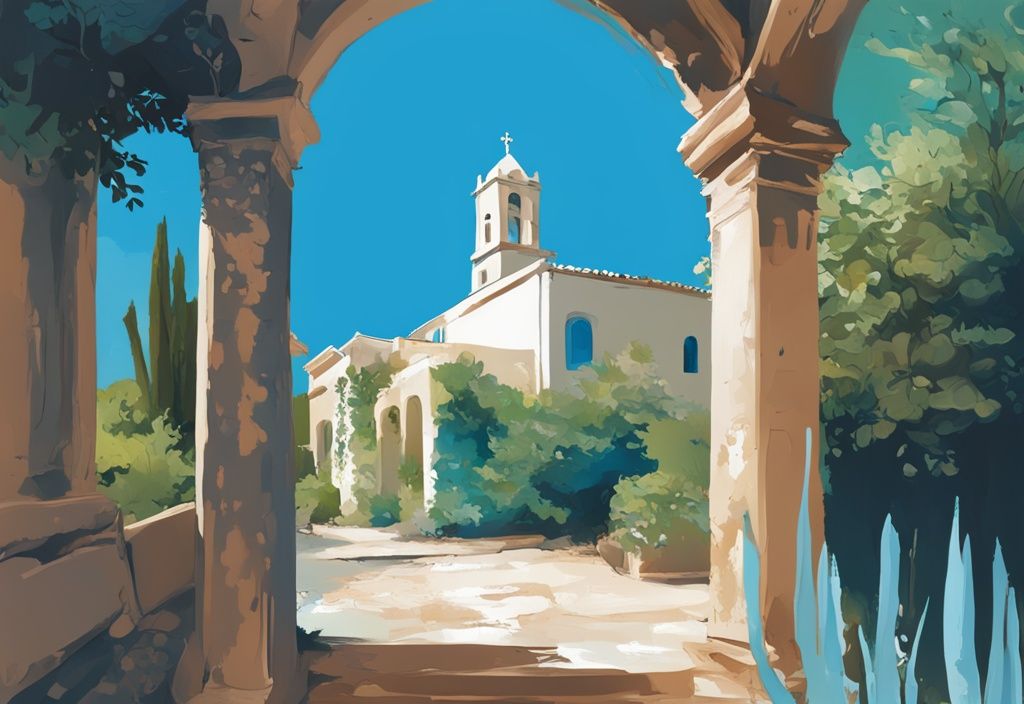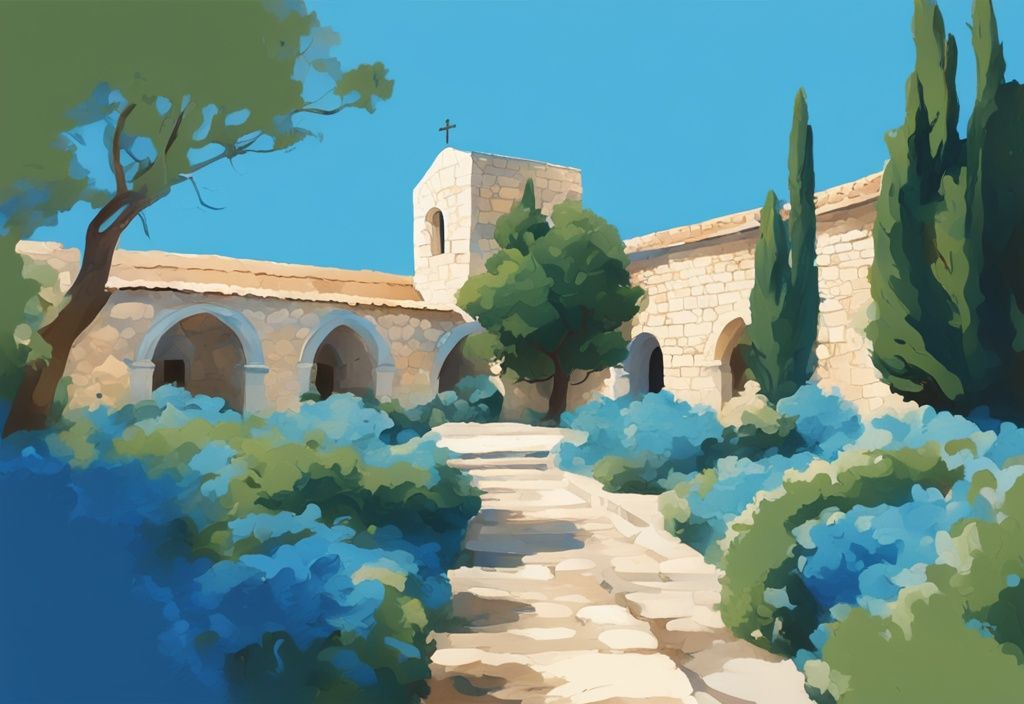Explore Historic Ayia Napa Monastery in Cyprus
Have you ever wondered about the secrets hidden within the ancient walls of Ayia Napa Monastery? As a native of Ayia Napa, I’m here to guide you through this historical and spiritual gem, tucked away in the heart of bustling Cyprus.
In this article, we’ll journey through time, exploring the monastery’s rich Venetian history and the miraculous icon of the Virgin Mary. You’ll get a taste of the architectural blend of Byzantine and Gothic styles, and the tranquility of its courtyards.
Whether you’re a history enthusiast, a spiritual seeker, or just curious about Ayia Napa’s cultural treasures, this guide will offer you an unforgettable experience. So, are you ready to delve into the enchanting world of Ayia Napa Monastery?
Introduction to Ayia Napa Monastery
Imagine strolling through the sun-dappled streets of Ayia Napa, Cyprus, with the scent of jasmine in the air and the gentle hum of the Mediterranean in the background. Nestled in the eastern part of this vibrant town lies the Ayia Napa Monastery, a beacon of historical and spiritual significance. This cherished site is dedicated to ‘Our Lady of the Forests,’ with ‘Ayia Napa’ translating to ‘Holy wooded valley’.
The origins of Ayia Napa Monastery are steeped in legend and devotion. Picture a hunter, deep in the forest, stumbling upon a hidden cave where an icon of the Virgin Mary lay concealed. This miraculous discovery transformed the site into a revered place of pilgrimage, drawing believers from far and wide. The Ayia Napa Monastery thus became a focal point for those seeking spiritual solace and divine intervention.
Today, the monastery serves not only as a religious sanctuary but also as a cultural landmark, reflecting the rich heritage and enduring faith of Cyprus. Its serene environment offers a peaceful retreat from the bustling nightlife of Ayia Napa, making it a must-visit destination for both tourists and pilgrims alike.
Whether you’re seeking a moment of quiet reflection or a deeper connection to the island’s history, the Ayia Napa Monastery offers a unique glimpse into the spiritual heart of Cyprus. Its tranquil gardens and ancient walls tell stories of devotion and resilience, inviting you to explore and reflect.
Historical Background of Ayia Napa Monastery
Discover the rich history and cultural significance of the Ayia Napa Monastery, a cornerstone of Ayia Napa’s heritage. From its origins to its transformation over the centuries, this sacred site offers a fascinating glimpse into the past.
Origins and Construction
The Ayia Napa Monastery, a significant historical and religious site, was built around 1500 AD. Constructed in the form of a Medieval Castle, the monastery reflects the architectural styles of the Venetian era. Originally, it served as a women’s convent, providing a secluded and spiritual environment for nuns.
The Venetian Era Influence
The architecture of the Ayia Napa Monastery is heavily influenced by the Venetian style, which was prevalent during its construction period. The design elements include fortified walls, arches, and intricate stonework, showcasing the grandeur and artistic sensibilities of the Venetian era.
The Legend of the Virgin Mary’s Icon
A pivotal moment in the history of the Ayia Napa Monastery is the discovery of an icon of the Virgin Mary by a hunter in a cave. This icon is believed to possess miraculous powers, which led to the establishment of the monastery as a revered pilgrimage site. The legend of the Virgin Mary’s icon continues to attract pilgrims from around the world.

Transformation Over the Centuries
Women’s Convent to Mixed Monastery
Initially, the Ayia Napa Monastery functioned solely as a women’s convent. However, over time, it transitioned into a mixed monastery, accommodating both male and female monastics. This change marked a significant shift in the monastery’s role and community structure.
Abandonment During Ottoman Rule
During the Ottoman rule, the Ayia Napa Monastery faced a period of abandonment. The political and social upheavals of the time led to its neglect, and it remained in a state of disuse for an extended period. This phase of abandonment left the monastery in a dilapidated condition.
Restoration in the 20th Century
The restoration of the Ayia Napa Monastery began in 1950, breathing new life into the historic site. In 1978, it was transformed into an Ecumenical Conference Centre, fostering interfaith dialogue and cooperation. In 2007, the administration of the monastery was taken over by the Holy Metropolis Constantia Ammochostos (Famagusta), ensuring its preservation and continued significance.
Architectural Features of Ayia Napa Monastery
The Ayia Napa Monastery is a captivating blend of historical architectural styles, offering visitors a glimpse into the rich cultural tapestry that defines this Mediterranean gem.
Byzantine and Gothic Styles
The Ayia Napa Monastery stands as a remarkable example of architectural synthesis, blending Byzantine and Gothic styles. This unique combination reflects the historical influences that have shaped the region. The Byzantine style is evident in the monastery’s robust and solid structure, characterized by thick walls and small, high windows. The Gothic influence, on the other hand, can be seen in the pointed arches and intricate stone carvings that adorn the building. This architectural fusion not only enhances the aesthetic appeal of the monastery but also tells a story of cultural and historical convergence.
The Central Courtyard and Fountain
One of the most striking features of the Ayia Napa Monastery is its expansive central courtyard. This open space is surrounded by various rooms and a two-story building, creating a serene and contemplative environment. At the heart of the courtyard lies a beautiful fountain, which serves as a focal point and adds to the tranquil ambiance. The courtyard is designed to be a place of reflection and gathering, offering visitors a peaceful retreat from the bustling surroundings. The presence of the fountain, with its gentle flow of water, further enhances the sense of calm and spirituality that pervades the monastery.
The Ancient Sycamore Tree
In front of the south gate of the Ayia Napa Monastery stands an ancient sycamore tree, believed to be over 600 years old. This venerable tree is not just a natural wonder but also a symbol of the monastery’s enduring legacy. Its sprawling branches and thick trunk have witnessed centuries of history, providing shade and solace to countless pilgrims and visitors. The sycamore tree adds a touch of timeless beauty to the monastery, reminding us of the deep roots and lasting significance of this sacred site. Its presence enhances the overall spiritual and historical atmosphere, making it a cherished landmark within the monastery grounds.
Religious Significance and Pilgrimage
The Miraculous Icon of the Virgin Mary
Nestled in the heart of Ayia Napa, the monastery is a beacon of faith, largely due to the miraculous icon of the Virgin Mary. This revered icon, discovered by a hunter in a cave, is believed to possess extraordinary powers. Its discovery transformed the Ayia Napa Monastery into a prominent pilgrimage site. Pilgrims from across the globe flock here, seeking blessings and immersing themselves in the spiritual atmosphere that envelops this sacred artifact. The icon’s miraculous reputation continues to inspire deep faith and devotion, making it a cornerstone of the monastery’s religious significance.
Ecumenical Conference Centre
In 1978, the Ayia Napa Monastery expanded its role and became an Ecumenical Conference Centre. This transformation has allowed it to serve as a vital hub for churches throughout Cyprus and the Middle East. The centre facilitates meaningful dialogue and cooperation among various Christian denominations, fostering a spirit of unity and understanding. By hosting diverse religious and ecumenical events, the Ayia Napa Monastery continues to play a crucial role in promoting interfaith harmony. The establishment of the conference centre underscores the monastery’s ongoing relevance in contemporary religious discourse.
New Church Dedicated to the Virgin Mary
In 1994, a new church dedicated to the Virgin Mary was constructed southwest of the Ayia Napa Monastery. This modern addition beautifully complements the historical and spiritual significance of the original monastery. The new church serves as an additional place of worship and reflection for pilgrims and visitors. Its construction reflects the enduring devotion to the Virgin Mary and the monastery’s commitment to accommodating the growing number of faithful. The new church enhances the spiritual landscape of Ayia Napa, offering a serene environment for prayer and contemplation.
Cultural and Social Impact
Ayia Napa Monastery is a cornerstone of both cultural and social life in this vibrant Mediterranean town. Its historical significance and picturesque setting make it a focal point for various activities that enrich the local community and attract visitors from around the globe.

Hosting Cultural Events
Ayia Napa Monastery is not just a religious site but also a vibrant cultural hub. Throughout the year, it hosts a variety of cultural events that draw both locals and tourists. Concerts featuring traditional Cypriot music, as well as international performances, are held in the monastery’s serene and historic surroundings. Art exhibitions showcasing the works of local and international artists add to the cultural richness of the site. These events provide a unique blend of historical ambiance and contemporary culture, making the monastery a dynamic venue for cultural expression.
Popular Wedding Venue
The picturesque setting of Ayia Napa Monastery makes it a highly sought-after location for weddings. Couples from around the world choose this venue for its romantic and historic charm. The beautiful architecture, combined with the lush surroundings and the ancient sycamore tree, provides a stunning backdrop for wedding ceremonies and photographs. The monastery’s tranquil atmosphere adds a sense of solemnity and grace to the occasion, making it an unforgettable experience for the bride, groom, and their guests.
Symbol of Faith and Devotion
Ayia Napa Monastery stands as a powerful symbol of faith and devotion, deeply rooted in the religious heritage of Cyprus. The discovery of the miraculous icon of the Virgin Mary in a cave on the site has made the monastery a significant pilgrimage destination. Pilgrims visit to seek blessings and to connect with the spiritual history of the place. The monastery’s continued use as a site for religious ceremonies and its role in the community reflect its enduring importance as a beacon of faith and devotion.
Visitor Information
Location and Accessibility
The Ayia Napa Monastery, a gem nestled in the heart of Ayia Napa, is a must-visit for anyone exploring this vibrant town. Its central location ensures that whether you’re staying nearby or coming from surrounding areas, the monastery is just a short walk or drive away. Open to the public and free of charge, this historical and spiritual landmark invites everyone to delve into its rich past without any cost barriers.
Guided Tours and Public Access
Visitors are warmly welcomed at the Ayia Napa Monastery, where they can immerse themselves in its profound history and stunning architecture. For those seeking a deeper connection, guided tours are available. These tours offer fascinating insights into the monastery’s origins, architectural styles, and its pivotal role in the religious and cultural tapestry of Cyprus. With regular visiting hours, public access is ensured, allowing everyone to experience the tranquility and historical significance of this sacred site.
Nearby Attractions and Amenities
Kybele Restaurant
After your visit to the Ayia Napa Monastery, treat yourself to a delightful meal at the nearby Kybele Restaurant. Renowned for its exceptional cuisine, Kybele offers a diverse menu that caters to various tastes. Its close proximity to the monastery makes it a convenient and enjoyable dining option for tourists looking to unwind and savor local flavors.
Local Wildlife and Cautions
The serene surroundings of the Ayia Napa Monastery are often graced by the presence of friendly cats, adding a touch of charm to the area. However, it’s important to be aware of the occasional snake sightings. While these encounters are rare, it’s wise to stay cautious and avoid overgrown or secluded spots. Enjoy the peaceful environment, but always remain mindful of your surroundings.
Current and Future Developments
Ayia Napa Monastery is undergoing exciting transformations that promise to enhance its historical charm while making it more accessible and engaging for visitors. Here’s a glimpse into the ongoing and upcoming projects at this iconic site.
Refurbishment and Accessibility
The Ayia Napa Monastery is currently undergoing significant refurbishment to preserve its historical and architectural integrity. While the exact reopening date remains uncertain, these renovations aim to enhance visitor experience and ensure the site’s longevity. Efforts are being made to improve accessibility, making it easier for people of all abilities to explore this historic landmark once it reopens.
Innovative Museum Project
One of the most exciting developments at the Ayia Napa Monastery is the creation of an innovative museum within the monastic building. This museum will offer a comprehensive look at the monastery’s rich history, from its origins to its role in contemporary society. Interactive exhibits and modern technology will provide visitors with an engaging and educational experience, making the history of Ayia Napa Monastery accessible to all.
Local Partnerships and Support
The refurbishment and museum projects are supported by a network of local partnerships. Key supporters include the Bishopric of Famagusta and the municipality of Ayia Napa. Collaborations with the Department of Antiquities of Cyprus and the Ayia Napa hotel association further bolster these efforts. These partnerships ensure that the Ayia Napa Monastery remains a treasured cultural and historical site, benefiting both locals and tourists alike.

Conclusion
The Ayia Napa Monastery stands as a significant testament to the rich religious heritage of Cyprus. Nestled in the heart of Ayia Napa, this historical site offers a serene and spiritual retreat, starkly contrasting the vibrant nightlife that the town is famous for. The monastery’s historical and architectural splendor, combined with its religious significance, makes it a unique destination for both tourists and pilgrims.
Beyond its spiritual allure, the Ayia Napa Monastery serves as a cultural hub, hosting a variety of events such as concerts and art exhibitions. These events not only celebrate the local culture but also attract visitors from around the world, further enhancing the monastery’s role as a center of community and cultural exchange.
For those seeking personal reflection, the tranquil environment of the Ayia Napa Monastery provides an ideal setting. Whether visiting for its historical significance, religious importance, or simply to enjoy the peaceful surroundings, the monastery continues to be a place of profound personal and communal significance.
In conclusion, the Ayia Napa Monastery is more than just a historical site; it is a living symbol of faith, culture, and community in Cyprus. Its enduring presence and multifaceted role ensure that it remains a cherished landmark for generations to come.
FAQ
Discovering Ayia Napa Monastery
What is the significance of Ayia Napa Monastery?
– Ayia Napa Monastery stands as a historical and spiritual landmark dedicated to ‘Our Lady of the Forests’. It’s renowned for the miraculous icon of the Virgin Mary, drawing pilgrims and history enthusiasts alike.
How can I visit Ayia Napa Monastery?
– Nestled in the heart of Ayia Napa, the monastery is easily accessible by foot or local transport. Whether you’re strolling through the vibrant town or hopping on a bus, you’ll find it conveniently located.
Are there any guided tours available?
– Absolutely! Guided tours are available, offering visitors a deeper dive into the monastery’s rich history and cultural significance. It’s a fantastic way to enrich your visit.
What are the main architectural features of the monastery?
– The monastery is an architectural gem, blending Byzantine and Gothic styles. Key features include a serene central courtyard, an elegant fountain, and an ancient sycamore tree that whispers tales of the past.
Is there an entry fee for Ayia Napa Monastery?
– Good news! Entry to Ayia Napa Monastery is free for all visitors, making it an accessible cultural experience for everyone.
What events are hosted at Ayia Napa Monastery?
– The monastery is a hub for cultural events, hosting concerts, art exhibitions, and more. It’s a lively spot where history and modern culture intertwine.
Can I get married at Ayia Napa Monastery?
– Yes, you can! The monastery is a sought-after wedding venue, cherished for its beautiful and romantic setting. It’s a dream location for many couples.
What should I be cautious about when visiting?
– While exploring the monastery grounds, be mindful of snakes in the area. It’s always good to stay aware of your surroundings.